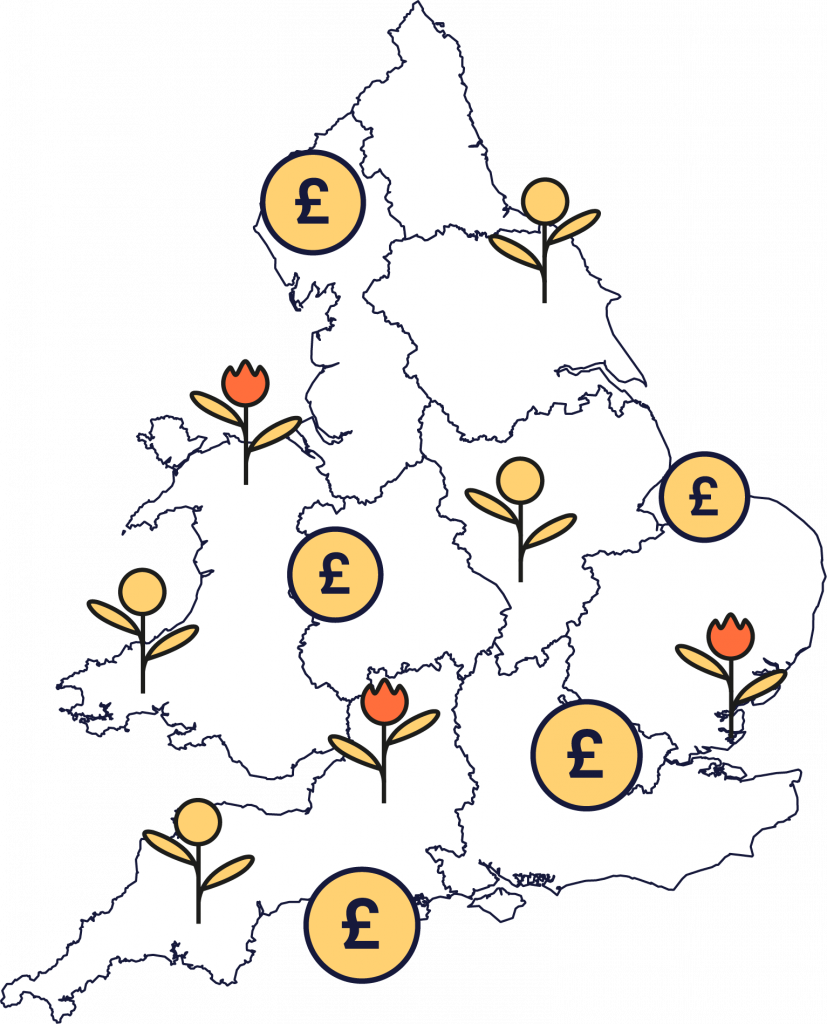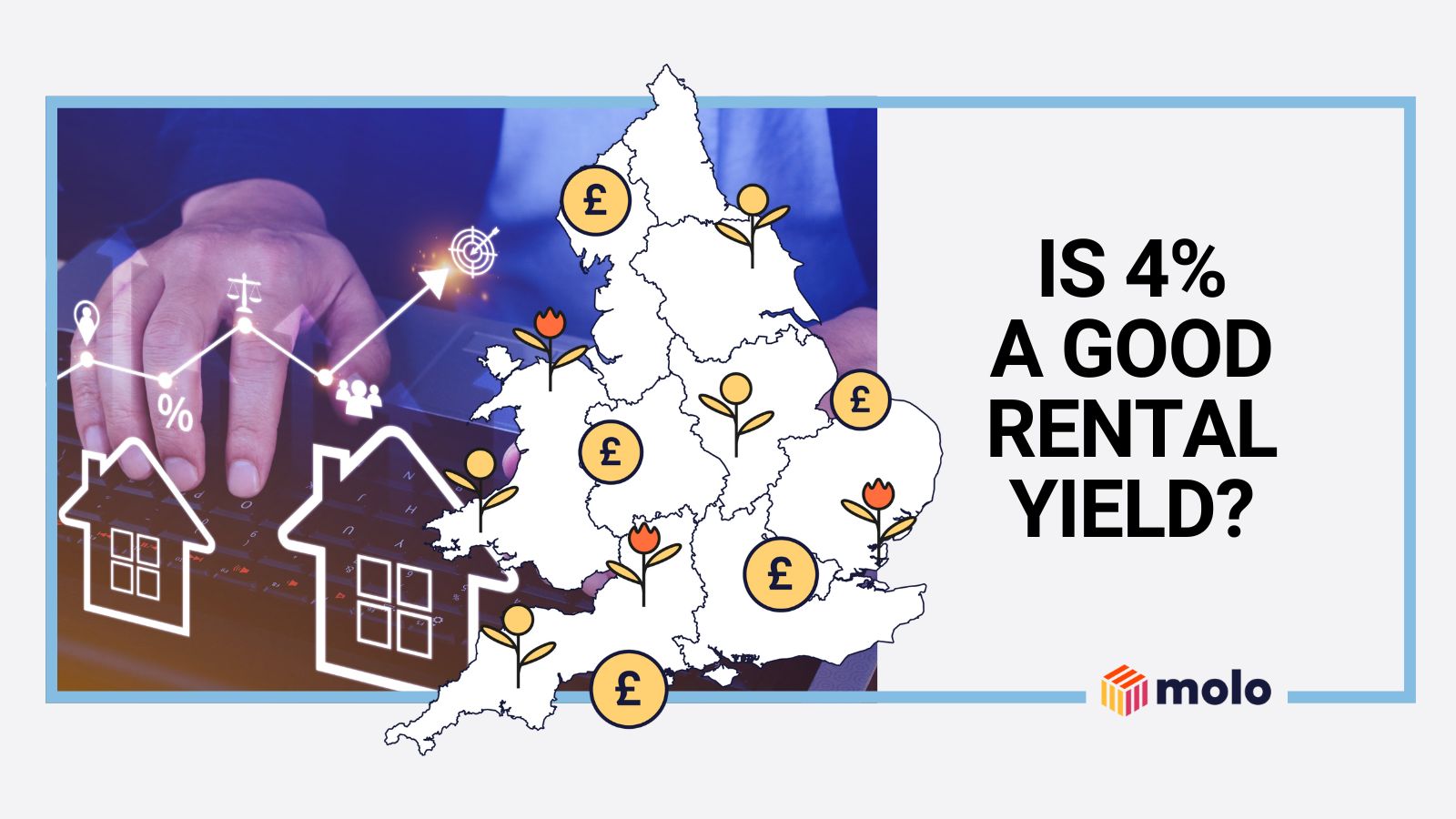If you’re contemplating joining the ranks of buy-to-let landlords, a key question looms: what rental yield should you set your sights on? In the UK, the average rental yield is around 5%, so does that mean anything less – like 4% – isn’t worth your time?
Here, we look at 4% as a rental yield figure and why even being below the average might not be the worst news. It’s all about context, after all.
What is a rental yield
If you’re looking for a quick refresher, a rental yield is a key metric used by landlords to evaluate the earning potential of an investment property. Expressed as a percentage, it’s calculated by taking the expected annual rental income from the property and dividing it by the total property value.
When assessing potential rental yields, you’ll need to understand the difference between gross and net figures. Gross yield looks only at the rental income generated before deducting any expenses, while net yield provides a more realistic picture as it calculates returns after all regular outgoings are paid.
Learn more about rental yields and how gross and net work
The role of a mortgage in your rental yield
Many landlords purchase their buy-to-let properties with a mortgage, which is one of the highest expenses. When assessing yields,factor in mortgage payments to determine your likely net rental income.
Interest rates on buy-to-let mortgages are higher than they have been over the 10 to 15 years adding upward pressure on costs. However, higher mortgage expenses can often be offset by increased rents – in the last 12 months, the average UK rent has increased by 6.2% in the year leading up to January 2024. Of course, it’s always important to consider all factors, including the tenant, when increasing rents.
Rental yield also plays a role in the loan amount lenders will approve. The higher the yield, the more comfortable lenders feel in extending credit. So maximising yield will not only directly lift investment returns, but it can also indirectly increase buying power.
Is 4% a good rental yield?
Whether a 4% rental yield represents a suitable return depends on a few key factors. With property markets varying hugely across the UK’s regions, averages don’t always tell the full story.
In higher-demand areas like London, where capital appreciation drives returns, achieving even 2-3% net rental yield would be respectable. Contrast that with cheaper northern regions, where yields upwards of 8% are attainable. So weigh up the tradeoff between yield and projected capital growth for your target locations.
Also consider whether quoted yields refer to gross or net figures. While a 4% gross yield seems healthy on the surface, expenses like maintenance and mortgage costs will eat into your actual profits. Prioritise comparing properties based on net yield projections which encapsulate the bulk of your expenses. What’s advertised as a 5% gross yield could effectively be only a 2-3% net return.
While 4% net yield has been a reasonable benchmark historically, today’s record-high property prices make hitting this figure tougher. Expanding your search area or considering smaller rental units can help lift yield potential.
As an informed starting point for yield expectations, 4% remains a solid marker especially if it’s net. But ultimately, you need to align targets to your budget, think about your risk appetite and the average yield in the locations of your property search.
Locations with highest rental yield
- Explore the map
- Calculate expected yield based on your property value
- Calculate the avg. monthly rent and compare results with any location on the map

Locations with a 4-plus percent rental yield
Here in the UK can you find cities that offer rental yields of 4% and higher? From London to Manchester, here are the areas offering 4% rental yields or more according to data from Molo.
Liverpool
Liverpool boasts an average rental yield of 6.40%, which is well above the UK average. Fuelling yield is surging demand from Liverpool’s large student population as well as young professionals flocking to the thriving city for its job prospects, culture and relative affordability. With major regeneration and infrastructure projects underway, the market still offers room for capital appreciation, too.
Cardiff
Offering strong rental yields, Wales’ capital Cardiff warrants a look from landlords. The city promotes an average rental yield of 5.20%. Propelling returns is strong tenant demand among the city’s substantial student community combined with its emerging tech and media job market. With such yields achievable today, Cardiff offers a compelling mix of strong cash flow and growth potential.
London
While London’s overall 3.8% average rental yield falls below the 4% benchmark, certain pockets of the capital tell a different story. Many outer boroughs such as Barking and Dagenham (4.44%) and Bexley (4.59%) exceed 4% returns currently, capturing overflow tenant demand. Even tourist-heavy Westminster offers prime yields around 4.12%, such is London’s enduring appeal among renters. So while London requires higher capital outlay, carefully selected properties can meet yield targets while benefiting from strong occupancy and growth.
Leeds
With rental yields coming in at 5.71%, Leeds is firmly on the radar of buy-to-let investors. Steady tenant demand is underpinned by its sizable student population, young professional demographic drawn by improving job prospects, and the city’s growing attraction among renters priced out elsewhere. As regeneration projects progress and transport links improve, Leeds’ market outlook remains positive, combining healthy yields today with solid capital growth potential.
Nottingham
With Nottingham clocking an average rental yield of 6.45%, the East Midlands city is on the radar for many buy-to-let investors. Healthy demand from Nottingham’s large student population combines with the city’s growing professional tenant base to drive yields. And with Nottingham a top pick for the government’s Levelling Up program, regeneration and improved transport links promise to further attract new residents.
Locations with highest rental yield
- Explore the map
- Calculate expected yield based on your property value
- Calculate the avg. monthly rent and compare results with any location on the map

Final thoughts: 4% rental yield
While a 4% rental yield can seem modest compared to some figures, in today’s market conditions it remains a reasonable target in many areas. Factoring in key variables like location, property type and net yields, returns of 4% or more are achievable for investors in many parts of the UK.



